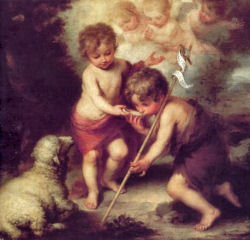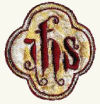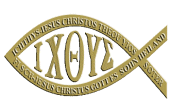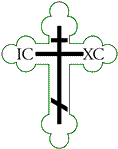"In the name of Jesus every knee should bow,
of those that are in heaven, on earth and under the earth"
Phil 2:10
The month of January is dedicated to the Holy Name of Jesus, which is celebrated on January 3.
Everything about our divine Lord is holy, including His Name. It was the Archangel Gabriel who first spoke the name of Jesus to His mother, “Behold, you will conceive in your womb and bear a son, and you shall name him Jesus” (Luke 1:31). The Archangel was only a messenger, so the name of Jesus was given to Him by the Father in Heaven.
Saint Peter was one of the first Apostles to speak with authority in the Holy Name of Jesus when he healed a crippled man saying, “I have neither silver nor gold, but what I do have I give you: in the name of Jesus Christ the Nazorean, rise and walk” (Acts 3:6). Saint Paul also exalted the holy name of Jesus when he said, “…at the name of Jesus every knee should bend, of those in heaven and on earth and under the earth, and every tongue confess that Jesus Christ is Lord, to the glory of God the Father” (Philippians 2:9–10). Saint Paul preached with power in the name of Jesus so often that even some itinerant Jewish exorcists tried to imitate him by commanding demons, “I adjure you by the Jesus whom Paul preaches” (Acts 19:13).
Throughout the history of the Church, Jesus’ name has been invoked as an instrument of personal faith in the Son of God, especially to command demons or simply to pray to Jesus in a repetitive and personal way. The liturgical Feast of the Most Holy Name of Jesus has been celebrated by the Church for many centuries, especially within various religious orders. In the fifteenth century, Saint Bernardine of Siena, a Franciscan friar, went on a preaching mission promoting devotion to the Most Holy Name. He encouraged people to revere Jesus’ name by placing the first three Greek letters of His name on their doors: IHS. Today, this Greek monogram of Jesus’ name is commonly seen in churches on tabernacles, altars, and in stained glass windows. In the sixteenth century, Saint Ignatius of Loyola had such a strong devotion to the Most Holy Name of Jesus that he adopted it as his seal as general of his newly founded order of the Jesuits; that monogram remains the Jesuits’ official seal today.
There is great power in the spoken name of Jesus. Repeating His name prayerfully or speaking it aloud brings Him close and gives you strength, provided you recite His name in faith. The name of Jesus casts out fear, arouses trust, and unites your heart to His. Sadly, the Most Holy Name of Jesus is so holy that the evil one often tempts people to invoke it as a curse when angry, without even considering what they are doing.
As we celebrate this holy memorial today, ponder the prayer below that is attributed to Saint Bernardine of Sienna, the Franciscan who spoke so fervently of Jesus’ name. Also, take time to close your eyes and prayerfully repeat His name over and over. As you go about your day, anytime you feel anxious or fearful, speak the name of Jesus. Know and believe that the divine name of our Lord brings Him close to you and bestows His grace in abundance.
Source: My Catholic Life
History of the Feast

This feast originated towards the end of the fifteenth century, and was instituted by the private authority of some bishops in Germany, Scotland, England, Spain, and Belgium. The Office and the Mass composed by Bernardine dei Busti (d. 1500) were approved by Sixtus IV. The feast was officially granted to the Franciscans 25 February, 1530, and spread over a great part of the Church.
The Office used at present is nearly identical with the Office of Bernardine dei Busti. The hymns “Jesu dulcis memoria”, “Jesu Rex admirabilis”, “Jesu decus angelicum”, usually ascribed to St. Bernard, are fragments of a very extensive “jubilus” or “cursus de aeterna sapientia” of some unknown author in the thirteenth century. For the beautiful sequence “Dulcis Jesus Nazarenus” (Morel, “Hymnen des Mittelalters”, 67) of Bernardine dei Busti the Franciscans substituted a prose sequence of modern origin: “Lauda Sion Salvatoris”.
— Excepted from the Catholic Encyclopedia
Monogram for the Holy Name
a) The Chi-Rho Symbol. The oldest monuments bearing this symbol date to the third century, the first being found on a burial inscription of a consul from the year 369. From the third century we have the following authentic forms: (1) the separate letters; (2) the superimposed letters; (3) the monogram cross.
 After the triumph of Christianity, the Chi-Rho monogram spread into all countries and found manifold use. It no longer served as a mere abbreviation of the sacred Name, but stood as a symbol for Christ the King. Artists often surrounded it with a laurel wreath or a circle. This signified Christ’s dominion over the world, or His triumph over all enemies of His kingdom.
After the triumph of Christianity, the Chi-Rho monogram spread into all countries and found manifold use. It no longer served as a mere abbreviation of the sacred Name, but stood as a symbol for Christ the King. Artists often surrounded it with a laurel wreath or a circle. This signified Christ’s dominion over the world, or His triumph over all enemies of His kingdom.
b) The IHS Symbol. The familiar abbreviation IHS is a symbol of the Name Jesus which has retained its popularity down through the centuries. It owes its spread to St. Bernardine of Siena, who had it placed on his banner, surrounded with twelve rays of the sun and surmounted by a cross. It soon became the most popular monogram for the holy Name of Jesus. By his fervent words St. Bernardine persuaded many priests to place the letters on altars or on the interior and exterior walls of churches. Many Italian cities responded to his efforts and put the monogram in large letters on the outer walls of their town halls, as may still be seen in Siena.
 What is its derivation? IHC is the abbreviation of the Greek ΙΗΣΟUΣ, i.e., Jesus (the first three letters of the word). The older form for the Greek sigma, S, resembled our capital C. In Christian antiquity this monogram does not occur too frequently and may not be older than the fifth century. In recent centuries the IHS has been falsely interpreted as Jesus Hominum Salvator, or even Jesu humilis societas (and regarded as a colophon for the Society of Jesus). Another interpretation that is sometimes made is In Hoc Signo (vinces), and out of the added v (for vinces) three nails are formed.
What is its derivation? IHC is the abbreviation of the Greek ΙΗΣΟUΣ, i.e., Jesus (the first three letters of the word). The older form for the Greek sigma, S, resembled our capital C. In Christian antiquity this monogram does not occur too frequently and may not be older than the fifth century. In recent centuries the IHS has been falsely interpreted as Jesus Hominum Salvator, or even Jesu humilis societas (and regarded as a colophon for the Society of Jesus). Another interpretation that is sometimes made is In Hoc Signo (vinces), and out of the added v (for vinces) three nails are formed.
c)  Ichthys. The early Church loved another monogram for our Savior’s name, the widely-used ICHTHYS. Christ’s full title was (in Greek): Iesous Christos Theou Yos Soter, Jesus Christ, Son of God, Savior. The initial letters of these five words form the Greek word ICHTHYS, which means fish. For this reason Christ is often pictured as a fish. Thus both the abbreviation and the picture became for the early Christians a secret symbol for the Redeemer. Yes, they even call our Lord “the great and pure Fish” (Aberkios tomb inscription, about 180). Tertullian presupposed popular familiarity with the fish symbol when he wrote about 200: “We (Christians) are born as little fishes in water after the model of our Ichthys Jesus Christ” (On Baptism, ch. 1).
Ichthys. The early Church loved another monogram for our Savior’s name, the widely-used ICHTHYS. Christ’s full title was (in Greek): Iesous Christos Theou Yos Soter, Jesus Christ, Son of God, Savior. The initial letters of these five words form the Greek word ICHTHYS, which means fish. For this reason Christ is often pictured as a fish. Thus both the abbreviation and the picture became for the early Christians a secret symbol for the Redeemer. Yes, they even call our Lord “the great and pure Fish” (Aberkios tomb inscription, about 180). Tertullian presupposed popular familiarity with the fish symbol when he wrote about 200: “We (Christians) are born as little fishes in water after the model of our Ichthys Jesus Christ” (On Baptism, ch. 1).
d) The Cross as a Symbol for the Divine Name. The similarity between the Chi-Rho symbol and the Cross is so apparent that it was not long before the  two became related artistically. The Cross and the divine Name serve as symbols of redemption, and as a means of protection against the attacks of the demons. Thus it became customary to put the cruciform monogram on doors and houses. One of the more common methods for the cruciform arrangement involved the use of the two words Φως and ξωη (light and life), terms which Christ applied to Himself in John 8:12; 11:25. Jesus is our Light and Life, for He gives us divine faith and grace. The liturgy desires, prays for, and obtains light and life for the living and the dead. Here we have the reason why the combination of the two concepts, light and life, in the form of a cross became such a popular word symbol in the early Church and is frequently found on doors of houses (Syria), on tombs, and also on ampullas, terracotta lamps, and other articles.
two became related artistically. The Cross and the divine Name serve as symbols of redemption, and as a means of protection against the attacks of the demons. Thus it became customary to put the cruciform monogram on doors and houses. One of the more common methods for the cruciform arrangement involved the use of the two words Φως and ξωη (light and life), terms which Christ applied to Himself in John 8:12; 11:25. Jesus is our Light and Life, for He gives us divine faith and grace. The liturgy desires, prays for, and obtains light and life for the living and the dead. Here we have the reason why the combination of the two concepts, light and life, in the form of a cross became such a popular word symbol in the early Church and is frequently found on doors of houses (Syria), on tombs, and also on ampullas, terracotta lamps, and other articles.
Prayer
Jesus, Name full of glory, grace, love, and strength! You are the refuge of those who repent, our banner of warfare in this life, the medicine of souls, the comfort of those who mourn, the delight of those who believe, the light of those who preach the true faith, the wages of those who toil, the healing of the sick. To You our devotion aspires; by You our prayers are received; we delight in contemplating You. O Name of Jesus, You are the glory of all the saints for eternity. Amen.
Source: My Catholic Life